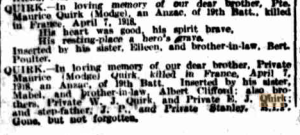A 20 minute read
This Anzac Day 2025, we remember the sacrifices of my paternal 2 x Great Uncle, Maurice Quirk.
Why do our Anzacs forebears command such reverence, out of all our ancestors and past family members? Each Anzac Day in April and Remembrance Day in November, we pause to remember those who fought so that we may all now enjoy freedom. It is built into our psyche to commemorate our fallen soldiers as a collective. But it goes deeper than this. As you start to delve into each individual soldier’s story, you begin to grasp the gravity of the loss. Our grandparents and great grandparents’ generations were so very deeply affected by two significant world wars and the losses that resulted. It changed the fabric of our society then, and its lessons still linger today. We must never forget the toll it took on those who sacrificed their lives in the pursuit of freedom, nor the toll on those left behind at home, who suffered unimaginable heartache. As we continue to lose the generations that lived through those heartbreak years, it becomes even more important to record the stories.
But where to start? Australia’s involvement in the Boer War, the first and second World Wars, the Korean and Vietnam wars will mean many Australians have a connection to a serviceman or servicewoman somewhere in the extended family tree. Or there will be a connection through a community, town or suburb.
The first step in locating war veterans in your family history is to search the National Archives of Australia website here; https://recordsearch.naa.gov.au/SearchNRetrieve/Interface/SearchScreens/BasicSearch.aspx
It can take time to work through the multiple scanned pages and identify the individual’s unit. After this, unit diaries can be consulted on the Australian War Memorial website here: https://www.awm.gov.au/collection/official-histories-rolls-unit-diaries
You can then start a timeline of events of the unit alongside the individual’s service record to understand which battles they may have been a part of. Knowing the names of the areas or battles your loved one fought in can bring about connections to media stories on Anzac Day, like the landings at Gallipoli at dawn or the Battle of Passchendaele, for example. And then there are the serendipitous finds, like in the process of researching this story, a quick google search of the Captain in charge at the time of Modge’s death uncovered a diary he had written, which revealed fascinating details of his and Modge’s war experiences. Suddenly all the times I had ever heard Gallipoli mentioned started to make sense, now knowing the exact locations and circumstances Modge would have found himself in, in that most commemorated of all war places.
This story of Modge and his war experiences can be read in conjunction with his brother Mick’s story here: https://quirkycharacters.com.au/stories/micks-war/
And his cousin Walter Faddy’s story here: https://quirkycharacters.com.au/stories/from-the-streets-to-the-trenches-walters-war/
Additionally there is the story of the Woollahra community and its WW1 losses. You can read it here: https://quirkycharacters.com.au/stories/i-waved-him-goodbye/
Modge’s family background and his early years can be found in the story about his mother Julia here: https://quirkycharacters.com.au/stories/shamrock-and-wattle-honouring-julias-struggle-to-survive/
I first learnt of Modge’s existence in the 1980s, through my great aunts, Modge’s nieces, who told me he had died ‘in the Great War.’ A fortuitus conversation with my great uncle Bob many years later revealed a tin full of old family photographs, held onto by Modge’s sister Eileen. Inside were the two photographs of Modge and the portrait of his ‘girl’, all shown in this story. My hope is that Modge is now remembered every April, not just by our family, but by others intrigued by his story. Forevermore it should serve as a reminder of a time when young men laid their lives down for the sake of others. And a reminder of how grateful we continue to be. Here is Modge’s story.
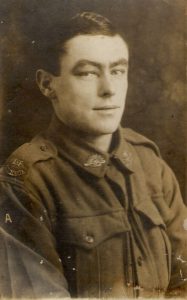
SYDNEY 1915
Maurice Quirk was born in December 1891 in the eastern Sydney suburb of Woollahra, the third son of James Quirk and Julia Walsh. Known as ‘Modge’ to his family and friends, he worked as a bootmaker up until March 1915, when he enlisted in the Australian Imperial Force (AIF), just a few months after the war began. Modge’s eldest brother Jack was already training in Egypt with the 1st Battalion when Modge took himself off to Victoria Barracks in Paddington, to sign up. Another brother, Mick, would also enlist and serve in the same battalion as Modge. The three brothers had more reasons than most to join the AIF. Their mother and father were recently deceased leaving the brothers orphaned by their early 20s with two younger sisters, Mabel and Eileen, to support. A taste of adventure, a steady wage or joining their mates might have all been reasons why the three boys joined the army.
Like the great majority of those who signed up for service during WW1, Modge was single. Just 22 years and 3 months old upon enlistment, weighing 119 pounds (54 kilograms) and standing just 5 feet 3 ¼ inches tall, Modge almost certainly had been forced to delay his enlistment until height restrictions were relaxed. On the 3rd March 1915, Private Maurice Quirk was given service number 961 and allocated to ‘C’ company of the 19th Battalion. Each battalion consisted of four companies, A, B, C & D. His brother Mick would end up in D company. Modge’s training took place at the Liverpool Barracks in Sydney for a period of three months. In June 1915, Modge embarked on HMAT Ceramic for overseas duty, alongside 32 officers and 979 other ranks of the 19th Battalion. Among these ranks was a man named Clarence (Clarrie) Wallach, also from Sydney’s eastern suburbs. Later becoming a Captain, Clarrie kept a diary of each day of the first few months in the army. The full diary can be read here:
https://s3-ap-southeast-2.amazonaws.com/awm-media/collection/RCDIG0000344/bundled/RCDIG0000344.pdf
Modge was now about to enter a whole other world, far removed from the one he had always known. Embarking on the ship in Sydney was just the start of a three-year adventure, that would take Modge to Egypt, Turkey, England, France, Belgium. It is through Clarrie’s recording of the events of 1915 that allows us a glimpse into what Modge might also have been feeling. As the ship prepared to sail on June 25, 1915 Clarrie ‘went on deck to see swarms of small boats with friends of the boys encircling the ship, saying goodbye.’ Perhaps sisters Mabel and Eileen were there to farewell him too. Soon each day would be defined by strict timings; drills at 6.30am, breakfast at 8am, rifle exercises at 11am, dinner at 1pm, more drills at 2.30pm, followed by free time. On July 6 all men were ordered ‘to have our hair cut short, great sport amongst those who failed to have it done, the barber gang went round the ship and anyone with long hair was arrested and clipped, no matter how he struggled and fought, they clipped him just the same.’ A week later the men had ‘machine gun practice at a kite in the air.’ This was followed by a concert at night and a boxing match the next night.
By 17 July they still had ‘no idea of our destination, except that we are in the Red Sea, weather very hot.’ Three days later they arrived at Suez where ‘Arabs, Egyptians and others swarm around the ship in everything that would float, offering their goods for sale.’ A day later the battalion was landed in the Egyptian capital ‘at 2am and marched out to Heliopolis camp. Up at daylight and visited Cairo in the afternoon.’ The Australians already had a reputation in Cairo with the 19th boys no doubt contributing to that. The battalion trained at the Heliopolis camp in Egypt for three weeks before ‘rumours that we are leaving for the front’ circulated on August 13. Three days later the battalion ‘arrived at Alexandria at 3am and embarked on the HMTS Saturnia, the dirtiest and filthiest ship imaginable, no arrangements for tucker, so we lived on bully (beef) and biscuits.’ They headed to Lemnos where the troops stood awaiting further orders. Shortly after they were transferred to the ship HMS Osmanieh.
GALLIPOLI
At 1am on August 21, Clarrie, Modge and the other men of the 19th Battalion arrived at the Dardanelles and landed under cover of darkness. The troops endured their first baptism of fire soon after, making their way from Reserve Gully to Beauchamp Gully. There was no sleep that first night on the Gallipoli peninsula with ‘bullets humming over our heads all night.’ The second day dawned with an even greater realisation, upon encountering the 18th Battalion, who had been ‘cut to pieces.’ Wise words of advice were offered by the wounded, ‘as the 18th boys were being carried past, they were shouting to us to keep our heads, and give the Turks one for them.’ The 19th Battalion was now a support for the action happening at Hill 60.
On August 23, the third day, Clarrie wrote of ‘digging ourselves in, connecting up with the Gurkhas on our right and the Tommies on our left. We were under heavy fire all the time, but were very lucky only losing about 5 out of our company.’ After digging all night and with exhaustion setting in, a reprieve finally came, with a call to cease digging. ‘We just dropped down in the trenches we had dug and went to sleep, the first (sleep) for three nights.’ The hardships didn’t end there. Clarrie describes a blazingly hot sun, limited water and millions of flies. The battalion was not relieved in the trenches until days later, on August 27, having endured ‘bullets humming past you like hail’ with hands ‘raw and bleeding’ from ‘the hardest work we have had so far.’ A swim in Anzac Cove was the reward for the incredible effort they had put in. Over the following days, the 19th was a support and witness to the bayonet attack on Hill 60 by the New Zealanders.
On September 5, the battalion’s Major McManamey was killed, ‘a mighty sad day for us, as he was looked up to as a father by all the boys.’ It came just days after Captain Wilson was also killed, dying in Clarrie’s arms. Death was now a daily reality, with the ‘heat, flies and stench from the dead bodies terrible.’ The Gallipoli Peninsula was a place where Modge was subjected to a ‘daily confrontation with hardship and danger.’ Aside from the obvious risk of snipers, bombs and machine gun fire, disease also spread quickly due to the unsanitary conditions of the battlefields where rotting bodies could lie for days or weeks in the heat. On September 13, the battalion marched four hours to Pope’s Post to relieve other battalions. It was here they fired their first shots of the war. It coincided with Clarrie coming down with dysentery, no surprise in the appalling circumstances.
Modge saw just a few weeks of action at Gallipoli, before being admitted to hospital on the 21st September 1915 suffering from rheumatic fever. This illness caused joint pain, fatigue and potential heart problems. Over 6,000 men were affected by the illness during the Gallipoli campaign. Modge was taken by ship to a hospital in Malta, before being transferred to a hospital in Wandsworth, near London, in England in October 1915. Modge was one of only 40 men from his battalion that was evacuated sick from Gallipoli, with over 250 others wounded or killed.
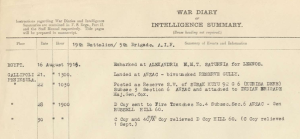
ENGLAND
In the five months following his evacuation from Gallipoli, and convalescence in England, it is likely that Modge met a young English girl. ‘One of the best’ he called her on the back of the photographic postcard he sent to his sister Eileen. This was perhaps a reference to her nursing abilities, a likely place for a young soldier to meet his love interest.
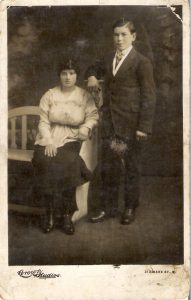
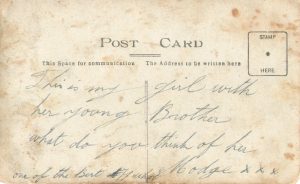
There is no easy way to identify who Modge’s girlfriend was without knowing her name. Modge did not reveal this vital detail. The only way her identity may come to light, is if she recorded his name somewhere and that document has survived and been handed down to her descendants and the information posted on a site like Ancestry.com. There is currently no public profile for a Maurice Quirk of a similar age associated with a fiancé during WW1 that might lead us to discovering this girl’s identity.
Around the same time, Modge sent another postcard to his sister Eileen from himself and his mate ‘Bluey’. Modge signed off the card with three kisses (xxx) and sent one kiss from Bluey as well. They may very well have been convalescing together in England. Bluey’s true identity is also not known.
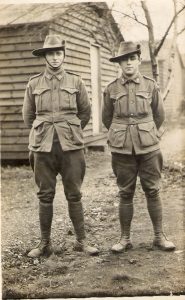
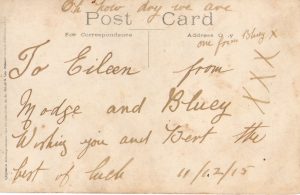
WESTERN FRONT
In early March 1916, Modge was well enough to be shipped back to Egypt for further training with the 19th Battalion, and shortly thereafter, embarked on the journey back to Europe, landing in France on the 25th March 1916. Two years of intense warfare would follow with barely any relief, in a place now known as the Western Front. Modge’s first entry in his Western Front record reveals a lack of discipline and disobedience, perhaps coming as a result of his long period of convalescence. On the 17th May 1916 he ‘failed to carry out a duty’, resulting in a penalty of 14 days Field Punishment No.2, which entailed heavy manual labour. This was a punishment Modge clearly learnt his lesson from, initially at least, as his record remained clear for almost a year afterwards.
In fact, he was soon keen to make up for his apparent lack of dedication. In June 1916, as the Allies were preparing for an offensive against the Germans on the Somme, a series of trench raids at Armentieres were planned to initiate the attack. The raids were designed to inflict damage on the Germans and ‘obtain prisoners, destroy machine-gun emplacements and capture equipment of any kind.’ Modge’s fellow Sydney-sider Clarrie Wallach, now a Lieutenant, was instructed to form a raiding party and asked for volunteers amongst his men. A total of 9 officers and 73 other ranks from various battalions of the 5th Brigade, including Modge, took part in raids on German trenches on the night of the 25th June 1916, south-east of Bois Grenier. The raids were considered very important and ultimately successful, with a loss of only 1 killed and 13 wounded on the Allied side, and 30 killed and 4 captured on the German side. Recognition was given to each of the men who participated by stamping the details onto their service record. A young soldier by the name of William Jackson (from the 17th Battalion) won the first Victoria Cross (VC) on the Western Front for his actions during these raids.
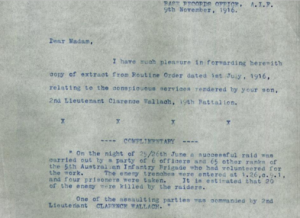
Modge’s participation in the Armentieres trench raids was a small taste of things to come. During 1916, the 19th Battalion would be involved in the battles of Pozieres, Mouquet Farm and The Maze. The first major offensive, Pozieres, took place between late July and late August 1916. During the battle, the Germans used many weapons to halt the Allied advancement, including explosives, shrapnel and gas. The continual bombardment of the men of the 2nd Division, including the 19th Battalion, holding the end of the line at Pozieres village, caused many men to be evacuated with shell shock, a psychological condition with symptoms ranging from mental breakdowns to nightmares and panic attacks. Although Modge appears to have escaped the battle with no injuries, two of his mates from Woollahra were not so lucky, suffering severe shell shock. The men of the 2nd Division held the line at Pozieres for 12 days, in a feat that has been called ‘arguably the most severe shelling endured over a prolonged period during the whole war.’ The battles of Pozieres, and later Mouquet Farm, fought in late August, inflicted around 8,000 casualties on the 2nd Division, severely weakening it and putting it out of action for a number of months.
It was to be November before the 19th Battalion saw action again, this time at The Maze, near Flers in Belgium. By now winter had started to bite and heavy rain had fallen. Charles Bean, a leading WW1 correspondent and photographer, observed that in order to keep warm whilst on duty in the trenches, the men were forced to regularly walk up and down the narrow trenches or stamp their feet on the spot, producing deep wells of mud. Frost bite led to ‘trench feet’, a condition that saw some men having their toes or feet amputated due to gangrene. Modge’s skills as a bootmaker would have been extremely useful both for himself and his battalion mates during the long winter months in France, repairing boots to help prevent trench foot casualties. Some men kept their spirits up during this time, using the long hours in the trenches to write letters home to family and friends. Modge’s cousin Walter Faddy (of the 18th Battalion) wrote home commenting light heartedly that the boys had ‘plenty of mud to kick about’. It was a common practice for the men to sanitise their letters so as not to worry their loved ones waiting at home. Others described that period as the ‘coldest winter in living memory.’
In mid-November 1916, during the battle of The Maze, the 19th Battalion held the position against the enemy for two days and nights. Many Germans were captured in trench raids, during which Modge’s mate, Private Bob Tidyman, was killed whilst guarding prisoners. ‘A man’s battalion was the centre of his existence’ and this would have been a terrible blow for Modge. The following year, 1917, was to prove just as tough as 1916. Modge and the rest of the 19th Battalion would fight their way through three more major battles, at Second Bullecourt, Menin Road and Broodseinde Ridge. The war raged on relentlessly, giving no relief. Each day brought hard physical labour, like digging and reinforcing trenches and marching to new battlegrounds with the ever-changing front line.
By April 1917, after twelve months of continuous service, Modge could wait no longer for a leave of absence to be approved. On April 3rd, he took matters into his own hands, somehow obtaining a forged leave pass and headed to the town of Amiens. Freedom did not last long however, for he was arrested by the Military Police just 18 hours later. More field punishment and forfeiture of pay followed, hopefully made more bearable by his short taste of freedom. Blemishes on a soldier’s war record were common and Modge’s contained three; the two charges of Absent without Leave and the charge of failing to carry out a duty. However there was recognition too. At the end of 1917, Modge was issued with two brass ‘A’ symbols to be placed on the sleeves of his uniform, signifying his involvement in the Gallipoli campaign. This marked him as an original member of the 19th Battalion, an experienced and valuable soldier.
Christmas Day 1917 for the 19th Battalion men was spent the same way as the previous year; holding the line. They had been moved to a location near Deûlémont, on the river Lys. (France/Belgium border). However, the men were better equipped than the previous year to deal with the freezing cold. Those in the front trenches had been issued with gum boots and on Christmas Day the men tucked into a stew and had a tipple of rum. It was an unusually quiet period with no enemies encountered during the night patrols and no casualties recorded from Christmas Eve to New Year’s Day 1918.
As another year came around, Modge would surely have been war weary and hoping for an end to the bloodshed. January 8 saw heavy snowfall and January 17 heavy rainfall, which resulted in all available men of the battalion draining and repairing the trenches. Then on January 20, a brief respite came in the form of leave to England or ‘Blighty leave’, as it was called. Modge had waited almost two years for this leave, supposed to be an annual privilege. Perhaps seizing the chance to spend more time with his fiancé, he unofficially extended his leave for an extra week, incurring a loss of 31 days’ pay. It is likely that the portrait Modge had taken of himself (wearing the A for Anzac on his sleeve) was done at this time.
Modge arrived back in France in mid-February 1918, at a time when both the Germans and the Allies were stepping up the campaign for victory as the war entered what would be its final year. The 19th Battalion would soon be drawn into the battles surrounding the town of Villers-Bretonneux. Leaving Nieppe on 24 March, the 19th Battalion headed for the Messines sector (now called Mesen, in Belgium). Two weeks later, the battalion was located near Villers-Bretonneux and on the 6th April, an order was given for an attack on the Germans at Hangard Wood. The war diaries of the 19th Battalion and the 5th Division paint a sobering picture of what unfolded for Modge.
It is not clear which company (consisting of somewhere between 100 to 225 men) Captain Clarrie Wallach was in command of, although it may have been ‘C’ company, of which Modge was a part. One platoon of ‘C’ company (30-60 men) took part in the attack, along with one platoon of ‘D’ company and some members of the 20th Battalion. The diaries reveal that;
‘At zero hour (5am), 20th Battalion (was) not in position, (so the) 19th commander decided to move off without them. The company moved through to (the) outer edge of wood without any frontal opposition but was troubled by machine gun fire from the right flank. On reaching the outer edge of (the) wood, (the) enemy forward trench was encountered. Only 2 officers and 10 other ranks had cleared the wood, these belonging to the right platoon of our company. The attention of this party was attracted by a large enemy party (strength about 80 to 100) who were holding up troops on the right and they immediately turned to this party and charged with bayonets from the rear, taking them by surprise and capturing about 60 prisoners. A large number of casualties was inflicted on the enemy and a Lewis gun was captured and brought back. (They) were noticed to be retreating and our party pushed on to and reached the objective line and linked up with 20th Battalion party who were on the left. Here the ground was covered with a thick growth about chest high and as this position offered no field of fire, officers of 19th and 20th Battalions consulted and decided to push further forward. After proceeding about 70 yards large numbers of (the) enemy, three to four hundred strong, were massed on a very steep hill in the immediate front and about 300 yards distant. Other enemy parties were moving on our right and left flanks and opened fire. There was still no field of fire open to our party owing to the undergrowth and after a consultation of (the) three officers present, it was agreed that the position was impossible and therefore (the) party moved back under pressure of heavy enemy machine gun and rifle fire. Report received from (the) stretcher bearing parties and others moving back indicate that the enemy has re-occupied the trench from which he was driven by the 19th Battalion party. Definitive casualties cannot yet be stated. Two officers are known to be killed and one wounded and one missing. Heavy casualties are expected amongst other ranks.’
Modge Quirk likely took the brunt of the German machine gun fire, dying where he fell. There was just six months of the war left. Modge’s body was retrieved and buried in Crucifix Corner Cemetery, at Villers-Bretonneux. He was one of the 33,407 Australians killed on the Western Front from 1916-1918.
Captain Percy Storkey, leading a group of men from the 19th Battalion, charged the Germans during this attack at Hangard Wood, for which he was awarded a Victoria Cross. Captain Clarrie Wallach, a talented footballer, was hit in both legs. He was transported to a hospital in England, where life-saving surgery meant amputation of one leg, followed by the other. He died, despite the best efforts to save him.
Over a dozen others from the 19th Battalion died that day at Hangard Wood, including;
Corporal Donald Anderson (479) from B company, a married Scotchman, wounded in the leg, close to the German line, who another man tried to drag to safety but couldn’t.
Lieutenant Leslie Hugh Bignell, killed outright by machine gun fire and buried in the vicinity of where he fell
Lt James Glen McDonald (1732), who had survived a previous gun-shot wound to the chest, killed close to the enemy line and unable to be retrieved when the enemy recaptured the area.
All of these army files make for harrowing reading.
In what was an additional blow to the families, some of the dead men’s personal items were being sent home onboard the HMAT Buronga when it was sunk by the Germans in July 1918. All souls on board were saved but the clothing, letters, photos and other precious mementos were all lost. Captain Wallach’s personal items were among those lost to the sea.
Modge’s death cast a dark shadow over an already grieving family. Jack and Mick, still on active duty on the Western Front, were no doubt deeply affected by their own war experiences but then also had to endure the loss of their brother and best mate. Mabel and Eileen lost a protector. And then there was Modge’s girlfriend. She may never have known what happened to Modge.
What we do know is that Modge was a much-cherished member of the extended Quirk and Poulter families. On the first anniversary of Modge’s death, his grieving siblings placed memorial notices in the Sydney Morning Herald.
His heart was good, his spirit brave,
His resting place, a hero’s grave.
Lest we forget
